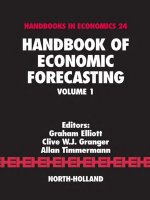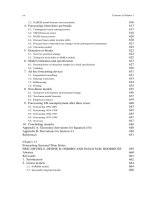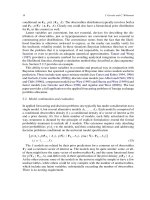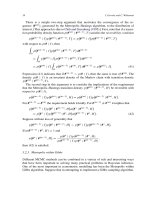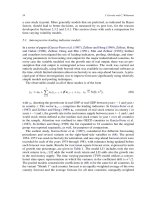Handbook of Economic Forecasting part 9 docx
Bạn đang xem bản rút gọn của tài liệu. Xem và tải ngay bản đầy đủ của tài liệu tại đây (126.86 KB, 10 trang )
54 J. Geweke and C. Whiteman
a case study in point. More generally models that are preferred, as indicated by Bayes
factors, should lead to better decisions, as measured by ex post loss, for the reasons
developed in Sections 2.3.2 and 2.4.1. This section closes with such a comparison for
time-varying volatility models.
5.1. Autoregressive leading indicator models
In a series of papers [Garcia-Ferer et al. (1987), Zellner and Hong (1989), Zellner, Hong
and Gulati (1990), Zellner, Hong and Min (1991), Min and Zellner (1993)] Zellner
and coauthors investigated the use of leading indicators, pooling, shrinkage, and time-
varying parameters in forecasting real output for the major industrialized countries. In
every case the variable modeled was the growth rate of real output; there was no pre-
sumption that real output is cointegrated across countries. The work was carried out
entirely analytically, using little beyond what was available in conventional software at
the time, which limited attention almost exclusively to one-step-ahead forecasts. A prin-
cipal goal of these investigations was to improve forecasts significantly using relatively
simple models and pooling techniques.
The observables model in all of these studies is of the form
(68)y
it
= α
0
+
3
s=1
α
s
y
i,t−s
+ β
z
i,t−1
+ ε
it
,ε
it
iid
∼ N
0,σ
2
,
with y
it
denoting the growth rate in real GNP or real GDP between year t −1 and year t
in country i. The vector z
i,t−1
comprises the leading indicators. In Garcia-Ferer et al.
(1987) and Zellner and Hong (1989) z
it
consisted of real stock returns in country i in
years t −1 and t, the growth rate in the real money supply between years t −1 and t, and
world stock return defined as the median real stock return in year t over all countries
in the sample. Attention was confined to nine OECD countries in Garcia-Ferer et al.
(1987).InZellner and Hong (1989) the list expanded to 18 countries but the original
group was reported separately, as well, for purposes of comparison.
The earliest study, Garcia-Ferer et al. (1987), considered five different forecasting
procedures and several variants on the right-hand-side variables in (68). The period
1954–1973 was used exclusively for estimation, and one-step-ahead forecast errors were
recorded for each of the years 1974 through 1981, with estimates being updated before
each forecast was made. Results for root mean square forecast error, expressed in units
of growth rate percentage, are given in Table 1. The model LI1 includes only the two
stock returns in z
it
; LI2 adds the world stock return and LI3 adds also the growth rate
in the real money supply. The time varying parameter (TVP) model utilizes a conven-
tional state-space representation in which the variance in the coefficient drift is σ
2
/2.
The pooled models constrain the coefficients in (68) to be the same for all countries. In
the variant “Shrink 1” each country forecast is an equally-weighted average of the own
country forecast and the average forecast for all nine countries; unequally-weighted
Ch. 1: Bayesian Forecasting 55
Table 1
Summary of forecast RMSE for 9 countries in Garcia-Ferer et al. (1987)
Estimation method
(None) OLS TVP Pool Shrink 1
Growth rate = 03.09
Random walk growth rate 3.73
AR(3) 3.46
AR(3)-LI1 2.70 2.52 3.08
AR(3)-LI2 2.39 2.62
AR(3)-LI3 2.23 1.82 2.22 1.78
Table 2
Summary of forecast RMSE for 18 countries in Zellner and Hong (1989)
Estimation method
(None) OLS Pool Shrink 1 Shrink 2
Growth rate = 03.07
Random walk growth rate 3.02
Growth rate = Past average 3.09
AR(3) 3.00
AR(3)-LI3 2.62 2.14 2.32 2.13
averages (unreported here) produce somewhat higher root mean square error of fore-
cast.
The subsequent study by Zellner and Hong (1989) extended this work by adding nine
countries, extending the forecasting exercise by three years, and considering an alterna-
tive shrinkage procedure. In the alternative, the coefficient estimates are taken to be a
weighted average of the least squares estimates for the country under consideration, and
the pooled estimates using all the data. The study compared several weighting schemes,
and found that a weight of one-sixth on the country estimates and five-sixths on the
pooled estimates minimized the out-of-sample forecast root mean square error. These
results are reported in the column “Shrink 2” in Table 2.
Garcia-Ferer et al. (1987) and Zellner and Hong (1989) demonstrated the returns
both to the incorporation of leading indicators and to various forms of pooling and
shrinkage. Combined, these two methods produce root mean square errors of forecast
somewhat smaller than those of considerably more complicated OECD official fore-
casts [see Smyth (1983)], as described in Garcia-Ferer et al. (1987) and Zellner and
Hong (1989). A subsequent investigation by Min and Zellner (1993) computed formal
posterior odds ratios between the most competitive models. Consistent with the results
described here, they found that odds rarely exceeded 2 : 1 and that there was no sys-
tematic gain from combining forecasts.
56 J. Geweke and C. Whiteman
5.2. Stationary linear models
Many routine forecasting situations involve linear models of the form y
t
= β
x
t
+ ε
t
,
in which ε
t
is a stationary process, and the covariates x
t
are ancillary – for example
they may be deterministic (e.g., calendar effects in asset return models), they may be
controlled (e.g., traditional reduced form policy models), or they may be exogenous and
modelled separately from the relationship between x
t
and y
t
.
5.2.1. The stationary AR(p) model
One of the simplest models of serial correlation in ε
t
is an autoregression of order p.
The contemporary Bayesian treatment of this problem [see Chib and Greenberg (1994)
or Geweke (2005, Section 7.1)] exploits the structure of MCMC posterior simulation al-
gorithms, and the Gibbs sampler in particular, by decomposing the posterior distribution
into manageable conditional distributions for each of several groups of parameters.
Suppose
ε
t
=
p
s=1
φ
s
ε
t−s
+ u
t
,u
t
| (ε
t−1
,ε
t−2
, )
iid
∼ N
0,h
−1
,
and
φ = (φ
1
, ,φ
p
)
∈ S
p
=
φ:
1 −
p
s=1
φ
s
z
s
= 0 ∀z: |z| 1
⊆ R
p
.
There are three groups of parameters: β, φ, and h. Conditional on φ, the likelihood
function is of the classical generalized least squares form and reduces to that of ordinary
least squares by means of appropriate linear transformations. For t = p+1, ,T these
transformations amount to y
∗
t
= y
t
−
p
s=1
φ
s
y
t−s
and x
∗
t
= x
t
−
p
s=1
x
t−s
φ
s
.For
t = 1, ,p the p Yule–Walker equations
⎡
⎢
⎢
⎢
⎣
1 ρ
1
ρ
p−1
ρ
1
1 ρ
p−2
.
.
.
.
.
.
.
.
.
.
.
.
ρ
p−1
ρ
p−2
1
⎤
⎥
⎥
⎥
⎦
⎛
⎜
⎜
⎝
φ
1
φ
2
.
.
.
φ
p
⎞
⎟
⎟
⎠
=
⎛
⎜
⎜
⎝
ρ
1
ρ
2
.
.
.
ρ
p
⎞
⎟
⎟
⎠
can be inverted to solve for the autocorrelation coefficients ρ = (ρ
1
, ,ρ
p
)
as a
linear function of φ. Then construct the p × p matrix R
p
(φ) =[ρ
|i−j|
],letA
p
(ρ)
be a Choleski factor of [R
p
(φ)]
−1
, and then take (y
∗
1
, ,y
∗
p
)
= A
p
(ρ)(y
1
, ,y
p
)
.
Creating x
∗
1
, ,x
∗
p
by means of the same transformation, the linear model y
∗
t
= β
x
∗
t
+
ε
∗
t
satisfies the assumptions of the textbook normal linear model. Given a normal prior
for β and a gamma prior for h, the conditional posterior distributions come from these
same families; variants on these prior distributions are straightforward; see Geweke
(2005, Sections 2.1 and 5.3).
Ch. 1: Bayesian Forecasting 57
On the other hand, conditional on β, h, X and y
o
,
e =
⎛
⎜
⎜
⎝
ε
p+1
ε
p+2
.
.
.
ε
T
⎞
⎟
⎟
⎠
and E =
⎡
⎢
⎢
⎢
⎣
ε
p
ε
1
ε
p+1
ε
2
.
.
.
.
.
.
ε
T −1
ε
T −p
⎤
⎥
⎥
⎥
⎦
are known. Further denoting X
p
=[x
1
, ,x
p
]
and y
p
= (y
1
, ,y
p
)
, the likelihood
function is
p
y
o
| X, β, φ,h
(69)= (2π)
−T/2
h
T/2
exp
−h(e − Eφ)
(e − Eφ)/2
(70)×
R
p
(φ)
−1/2
exp
−h
y
o
p
− X
p
β
R
p
(φ)
−1
y
o
p
− X
p
β
/2
.
The expression (69), treated as a function of φ, is the kernel of a p-variate normal distri-
bution. If the prior distribution of φ is Gaussian, truncated to S
p
, then the same is true of
the product of this prior and (69). (Variants on this prior can be accommodated through
reweighting as discussed in Section 3.3.2.) Denote expression (70) as r(β,h,φ), and
note that, interpreted as a function of φ, r(β,h,φ) does not correspond to the kernel
of any tractable multivariate distribution. This apparent impediment to an MCMC al-
gorithm can be addressed by means of a Metropolis within Gibbs step, as discussed
in Section 3.2.3. At iteration m a Metropolis within Gibbs step for φ draws a candi-
date φ
∗
from the Gaussian distribution whose kernel is the product of the untruncated
Gaussian prior distribution of φ and (69), using the current values β
(m)
of β and h
(m)
of h.From(70) the acceptance probability for the candidate is
min
r(β
(m)
,h
(m)
, φ
∗
)I
S
p
(φ
∗
)
r(β
(m)
,h
(m)
, φ
(m−1)
)
, 1
.
5.2.2. The stationary ARMA(p, q) model
The incorporation of a moving average component
ε
t
=
p
s=1
φ
s
ε
t−s
+
q
s=1
θ
s
u
t−s
+ u
t
adds the parameter vector θ = (θ
1
, ,θ
q
)
and complicates the recursive structure.
The first broad-scale attack on the problem was Monahan (1983) who worked without
the benefit of modern posterior simulation methods and was able to treat only p + q
2. Nevertheless he produced exact Bayes factors for five alternative models, and
obtained up to four-step ahead predictive means and standard deviations for each model.
He applied his methods in several examples developed originally in Box and Jenkins
(1976). Chib and Greenberg (1994) and Marriott et al. (1996) approached the problem
by means of data augmentation, adding unobserved pre-sample values to the vector of
58 J. Geweke and C. Whiteman
unobservables. In Marriott et al. (1996) the augmented data are ε
0
= (ε
0
, ,ε
1−p
)
and u
0
= (u
0
, ,u
1−q
)
. Then [see Marriott et al. (1996, pp. 245–246)]
(71)p(ε
1
, ,ε
T
| φ, θ,h,ε
0
, u
0
) = (2π)
−T/2
h
T/2
exp
−h
T
t=1
(ε
t
− μ
t
)
2
/2
with
(72)μ
t
=
p
s=1
φ
s
ε
t−s
−
t−1
s=1
θ
s
(ε
t−s
− μ
t−s
) −
q
s=t
θ
s
ε
t−s
.
(The second summation is omitted if t = 1, and the third is omitted if t>q.)
The data augmentation scheme is feasible because the conditional posterior density
of u
0
and ε
0
,
(73)p(ε
0
, u
0
| φ, θ,h,X
T
, y
T
)
is that of a Gaussian distribution and is easily computed [see Newbold (1974)]. The
product of (73) with the density corresponding to (71)–(72) yields a Gaussian kernel
for the presample ε
0
and u
0
. A draw from this distribution becomes one step in a Gibbs
sampling posterior simulation algorithm. The presence of (73) prevents the posterior
conditional distribution of φ and θ from being Gaussian. This complication may be
handled just as it was in the case of the AR(p) model, using a Metropolis within Gibbs
step.
There are a number of variants on these approaches. Chib and Greenberg (1994) show
that the data augmentation vector can be reduced to max(p, q +1) elements, with some
increase in complexity. As an alternative to enforcing stationarity in the Metropolis
within Gibbs step, the transformation of φ to the corresponding vector of partial auto-
correlations [see Barndorff-Nielsen and Schou (1973)] may be inverted and the Jacobian
computed [see Monahan (1984)], thus transforming S
p
to a unit hypercube. A similar
treatment can restrict the roots of 1 −
q
s=1
θ
s
z
s
to the exterior of the unit circle [see
Marriott et al. (1996)].
There are no new essential complications introduced in extending any of these mod-
els or posterior simulators from univariate (ARMA) to multivariate (VARMA) models.
On the other hand, VARMA models lead to large numbers of parameters as the number
of variables increases, just as in the case of VAR models. The BVAR (Bayesian Vector
Autoregression) strategy of using shrinkage prior distributions appears not to have been
applied in VARMA models. The approach has been, instead, to utilize exclusion restric-
tions for many parameters, the same strategy used in non-Bayesian approaches. In a
Bayesian set-up, however, uncertainty about exclusion restrictions can be incorporated
in posterior and predictive distributions. Ravishanker and Ray (1997a) do exactly this,
in extending the model and methodology of Marriott et al. (1996) to VARMA models.
Corresponding to each autoregressive coefficient φ
ij s
there is a multiplicative Bernoulli
random variable γ
ij s
, indicating whether that coefficient is excluded, and similarly for
Ch. 1: Bayesian Forecasting 59
each moving average coefficient θ
ij s
there is a Bernoulli random variable δ
ij s
:
y
it
=
n
j=1
p
s=1
γ
ij s
φ
ij s
y
j,t−s
+
n
j=1
q
s=1
θ
ij s
δ
ij s
ε
j,t−s
+ ε
it
(i = 1, ,n).
Prior probabilities on these random variables may be used to impose parsimony, both
globally and also differentially at different lags and for different variables; independent
Bernoulli prior distributions for the parameters γ
ij s
and δ
ij s
, embedded in a hierarchical
prior with beta prior distributions for the probabilities, are the obvious alternatives to ad
hoc non-Bayesian exclusion decisions, and are quite tractable. The conditional posterior
distributions of the γ
ij s
and δ
ij s
are individually conditionally Bernoulli. This strategy
is one of a family of similar approaches to exclusion restrictions in regression models
[see George and McCulloch (1993) or Geweke (1996b)] and has also been employed
in univariate ARMA models [see Barnett, Kohn and Sheather (1996)]. The posterior
MCMC sampling algorithm for the parameters φ
ij s
and δ
ij s
also proceeds one parameter
at a time; Ravishanker and Ray (1997a) report that this algorithm is computationally
efficient in a three-variable VARMA model with p = 3, q = 1, applied to a data set
with 75 quarterly observations.
5.3. Fractional integration
Fractional integration, also known as long memory, first drew the attention of econo-
mists because of the improved multi-step-ahead forecasts provided by even the simplest
variants of these models as reported in Granger and Joyeux (1980) and Porter-Hudak
(1982). In a fractionally integrated model (1 − L)
d
y
t
= u
t
, where
(1 − L)
d
=
∞
j=0
d
j
(−L)
j
=
∞
j=1
(−1)
j
(d −1)
(j − 1)(d − j − 1)
L
j
and u
t
is a stationary process whose autocovariance function decays geometrically. The
fully parametric version of this model typically specifies
(74)φ(L)(1 − L)
d
(y
t
− μ) = θ(L)ε
t
,
with φ(L) and θ(L) being polynomials of specified finite order and ε
t
being serially
uncorrelated; most of the literature takes ε
t
iid
∼ N(0,σ
2
). Sowell (1992a, 1992b) first de-
rived the likelihood function and implemented a maximum likelihood estimator. Koop
et al. (1997) provided the first Bayesian treatment, employing a flat prior distribution
for the parameters in φ(L) and θ(L), subject to invertibility restrictions. This study
used importance sampling of the posterior distribution, with the prior distribution as the
source distribution. The weighting function w(θ) is then just the likelihood function,
evaluated using Sowell’s computer code. The application in Koop et al. (1997) used
quarterly US real GNP, 1947–1989, a standard data set for fractionally integrated mod-
els, and polynomials in φ(L) and θ(L) up to order 3. This study did not provide any
60 J. Geweke and C. Whiteman
evaluation of the efficiency of the prior density as the source distribution in the impor-
tance sampling algorithm; in typical situations this will be poor if there are a half-dozen
or more dimensions of integration. In any event, the computing times reported
3
indicate
that subsequent more sophisticated algorithms are also much faster.
Much of the Bayesian treatment of fractionally integrated models originated with
Ravishanker and coauthors, who applied these methods to forecasting. Pai and Ravi-
shanker (1996) provided a thorough treatment of the univariate case based on a
Metropolis random-walk algorithm. Their evaluation of the likelihood function differs
from Sowell’s. From the autocovariance function r(s) corresponding to (74) given in
Hosking (1981) the Levinson–Durbin algorithm provides the partial regression coeffi-
cients φ
k
j
in
(75)μ
t
= E(y
t
| Y
t−1
) =
t−1
j=1
φ
t−1
j
y
t−j
.
The likelihood function then follows from
(76)y
t
| Y
t−1
∼ N
μ
t
,ν
2
t
,ν
2
t
=
r(0)/σ
2
t−1
j=1
1 −
φ
j
j
2
.
Pai and Ravishanker (1996) computed the maximum likelihood estimate as discussed
in Haslett and Raftery (1989). The observed Fisher information matrix is the variance
matrix used in the Metropolis random-walk algorithm, after integrating μ and σ
2
ana-
lytically from the posterior distribution. The study focused primarily on inference for
the parameters; note that (75)–(76) provide the basis for sampling from the predictive
distribution given the output of the posterior simulator.
A multivariate extension of (74), without cointegration, may be expressed
(L)D(L)(y
t
− μ) = (L)ε
t
in which y
t
is n × 1, D(L) = diag[(1 − L)
d
1
, ,(1 − L)
d
n
], (L) and (L) are
n × n matrix polynomials in L of specified order, and ε
t
iid
∼ N(0, ). Ravishanker and
Ray (1997b, 2002) provided an exact Bayesian treatment and a forecasting application
of this model. Their approach blends elements of Marriott et al. (1996) and Pai and
Ravishanker (1996). It incorporates presample values of z
t
= y
t
− μ and the pure
fractionally integrated process a
t
= D(L)
−1
ε
t
as latent variables. The autocovariance
function R
a
(s) of a
t
is obtained recursively from
r
a
(0)
ij
= σ
ij
(1 − d
i
− d
j
)
(1 − d
i
)(1 − d
j
)
,r
a
(s)
ij
=−
1 − d
i
− s
s − d
j
r
a
(s − 1)
ij
.
3
Contrast Koop et al. (1997, footnote 12) with Pai and Ravishanker (1996, p. 74).
Ch. 1: Bayesian Forecasting 61
The autocovariance function of z
t
is then
R
z
(s) =
∞
i=1
∞
j=0
i
R
a
(s + i − j)
j
where the coefficients
j
are those in the moving average representation of the ARMA
part of the process. Since these decay geometrically, truncation is not a serious issue.
This provides the basis for a random walk Metropolis-within-Gibbs step constructed
as in Pai and Ravishanker (1996). The other blocks in the Gibbs sampler are the pre-
sample values of z
t
and a
t
,plusμ and . The procedure requires on the order of n
3
T
2
operations and storage of order n
2
T
2
; T = 200 and n = 3 requires a gigabyte of
storage. If likelihood is computed conditional on all presample values being zero the
problem is computationally much less demanding, but results differ substantially.
Ravishanker and Ray (2002) provide details of drawing from the predictive den-
sity, given the output of the posterior simulator. Since the presample values are a
by-product of each iteration, the latent vectors a
t
can be computed by means of
a
t
=−
p
i=1
i
z
t−i
+
q
i=1
r
a
t−r
. Then sample a
t
forward using the autocovariance
function of the pure long-memory process, and finally apply the ARMA recursions to
these values. The paper applies a simple version of the model (n = 3; q = 0; p = 0or1)
to sea temperatures off the California coast. The coefficients of fractional integration are
all about 0.4 when p = 0; p = 1 introduces the usual difficulties in distinguishing be-
tween long memory and slow geometric decay of the autocovariance function. There
are substantial interactions in the off-diagonal elements of (L), but the study does not
take up fractional cointegration.
5.4. Cointegration and error correction
Cointegration restricts the long-run behavior of multivariate time series that are other-
wise nonstationary. Error correction models (ECMs) provide a convenient representa-
tion of cointegration, and there is by now an enormous literature on inference in these
models. By restricting the behavior of otherwise nonstationary time series, cointegra-
tion also has the promise of improving forecasts, especially at longer horizons. Coming
hard on the heels of Bayesian vector autoregressions, ECMs were at first thought to be
competitors of VARs:
One could also compare these results with estimates which are obviously mis-
specified such as least squares on differences or Litterman’s Bayesian Vector Au-
toregression which shrinks the parameter vector toward the first difference model
which is itself misspecified for this system. The finding that such methods provided
inferior forecasts would hardly be surprising. [Engle and Yoo (1987, pp. 151–152)]
Shoesmith (1995) carefully compared and combined the error correction specification
and the prior distributions pioneered by Litterman, with illuminating results. He used the
62 J. Geweke and C. Whiteman
quarterly, six-lag VARin Litterman (1980) for real GNP, the implicit GNP price deflator,
real gross private domestic investment, the three-month treasury bill rate and the money
supply (M1). Throughout the exercise, Shoesmith repeatedly tested for lag length and
the outcome consistently indicated six lags. The period 1959:1 through 1981:4 was the
base estimation period, followed by 20 successive five-year experimental forecasts: the
first was for 1982:1 through 1986:4; and the last was for 1986:4 through 1991:3 based
on estimates using data from 1959:1 through 1986:3. Error correction specification tests
were conducted using standard procedures [see Johansen (1988)]. For all the samples
used, these procedures identified the price deflator as I(2), all other variables as I(1),
and two cointegrating vectors.
Shoesmith compared forecasts from Litterman’s model with six other models. One,
VAR/I1, was a VAR in I(1) series (i.e., first differences for the deflator and levels for
all other variables) estimated by least squares, not incorporating any shrinkage or other
prior. The second, ECM, was a conventional ECM, again with no shrinkage. The other
four models all included the Minnesota prior. One of these models, BVAR/I1, differs
from Litterman’s model only in replacing the deflator with its first difference. Another,
BECM, applies the Minnesota prior to the conventional ECM, with no shrinkage or
other restrictions applied to the coefficients on the error correction terms. Yet another
variant, BVAR/I0, applies the Minnesota prior to a VAR in I(0) variables (i.e., sec-
ond differences for the deflator and first differences for all other variables). The final
model, BECM/5Z, is identical to BECM except that five cointegrating relationships are
specified, an intentional misreading of the outcome of the conventional procedure for
determining the rank of the error correction matrix.
The paper offers an extensive comparison of root mean square forecasting errors for
all of the variables. These are summarized in Table 3, by first forming the ratio of mean
square error in each model to its counterpart in Litterman’s model, and then averaging
the ratios across the six variables.
The most notable feature of the results is the superiority of the BECM forecasts,
which is realized at all forecasting horizons but becomes greater at more distant hori-
zons. The ECM forecasts, by contrast, do not dominate those of either the original
Litterman VAR or the BVAR/I1, contrary to the conjecture in Engle and Yoo (1987).
The results show that most of the improvement comes from applying the Minnesota
prior to a model that incorporates stationary time series: BVAR/I0 ranks second at all
horizons, and the ECM without shrinkage performs poorly relative to BVAR/I0 at all
horizons. In fact the VAR with the Minnesota prior and the error correction models are
not competitors, but complementary methods of dealing with the profligate parameter-
ization in multivariate time series by shrinking toward reasonable models with fewer
parameters. In the case of the ECM the shrinkage is a hard, but data driven, restriction,
whereas in the Minnesota prior it is soft, allowing the data to override in cases where
the more parsimoniously parameterized model is less applicable. The possibilities for
employing both have hardly been exhausted. Shoesmith (1995) suggested that this may
be a promising avenue for future research.
Ch. 1: Bayesian Forecasting 63
Table 3
Comparison of forecast RMSE in Shoesmith (1995)
Horizon
1 quarter 8 quarters 20 quarters
VA R/I1 1 .33 1.00 1.14
ECM 1.28 0.89 0.91
BVAR/I1 0.97 0.96 0.85
BECM 0.89 0.72 0.45
BVAR/I0 0.95 0.87 0.59
BECM/5Z 0.99 1.02 0.88
This experiment incorporated the Minnesota prior utilizing the mixed estimation
methods described in Section 4.3, appropriate at the time to the investigation of the
relative contributions of error correction and shrinkage in improving forecasts. More
recent work has employed modern posterior simulators. A leading example is Villani
(2001), which examined the inflation forecasting model of the central bank of Sweden.
This model is expressed in error correction form
(77)y
t
= μ + αβ
y
t−1
+
p
s=1
s
y
t−s
+ ε
t
, ε
t
iid
∼ N(0, ).
It incorporates GDP, consumer prices and the three-month treasury rate, both Swedish
and weighted averages of corresponding foreign series, as well as the trade-weighted
exchange rate. Villani limits consideration to models in which β is 7 × 3, based on
the bank’s experience. He specifies four candidate coefficient vectors: for example, one
based on purchasing power parity and another based on a Fisherian interpretation of
the nominal interest rate given a stationary real rate. This forms the basis for compet-
ing models that utilize various combinations of these vectors in β, as well as unknown
cointegrating vectors. In the most restrictive formulations three vectors are specified
and in the least restrictive all three are unknown. Villani specifies conventional uninfor-
mative priors for α, β and , and conventional Minnesota priors for the parameters
s
of the short-run dynamics. The posterior distribution is sampled using a Gibbs sampler
blocked in μ, α, β, {
s
} and .
The paper utilizes data from 1972:2 through 1993:3 for inference. Of all of the
combinations of cointegrating vectors, Villani finds that the one in which all three are
unrestricted is most favored. This is true using both likelihood ratio tests and an informal
version (necessitated by the improper priors) of posterior odds ratios. This unrestricted
specification (“β empirical” in the table below), as well as the most restricted one (“β
specified”), are carried forward for the subsequent forecasting exercise. This exercise
compares forecasts over the period 1994–1998, reporting forecast root mean square er-
rors for the means of the predictive densities for price inflation (“Bayes ECM”). It also
computes forecasts from the maximum likelihood estimates, treating these estimates as

